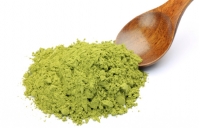Health Protective Effects of Phytonutrients: Green Tea Extract
The widely available extract from green tea is a combination of different phytonutrients (polyphenols) present in the tea leaves, which claim various health benefits. Green tea polyphenols have potent antioxidant and anti-inflammatory properties contributing to their anti-cancer and cardiovascular benefits and support of overall health. Recent research also shows that green tea offers health benefits in several conditions, such as rheumatoid arthritis, atherosclerosis, Alzheimer's disease, and so on.
Green tea contains between 30-40 percent of water-extractable polyphenols. Among the active constituents of green tea, epigallocatechin gallate (EGCG) has the greatest potential for its antioxidant and anticarcinogenic properties. Yet, the other components like epicatechin, epigallocatechin and epicatechin Gallate also help to enhance the actions of EGCG as a part of the green tea extract. EGCG is important for stimulating the production of the glutathione S-transferase (GST) enzyme that plays an important role in the body’s defense against cancer.
EGCG has multifaceted action in cancer prevention and carcinogenesis. It works in synergy with other micronutrients such as vitamin C, Lysine, and proline in simultaneously controlling multiple mechanisms in cancer growth and spread. Several studies conducted at our institute have proven that the specific micronutrient combination containing EGCG is effective in preventing metastasis by inhibiting the action of collagen digesting enzymes, and in addition can inhibit growth of new blood vessels to the tumor (anti-angiogenesis). The matrix metalloproteinases (MMP) enzymes secreted by cancer cells break down the cellular basement membrane thus enhancing the potential of the spread of cancer. EGCG inhibits the MMP enzymes and reduces their secretion and helps in reconstitution of the basement membrane. EGCG and other constituents of green tea extract are also effective in inducing cancer cell death (apoptosis). The effectiveness of this micronutrient synergy, specifically the anticarcinogenic effects, were confirmed and published by us in more than 80 scientific studies.
When used alone, EGCG tends to have a higher concentration only in the digestive system. However, the EGCG bioavailability gradually decreases due to oxidation and metabolism. Effectively, much less EGCG reaches the blood and other tissues, indicating that the potency of EGCG is lost during its absorption from the digestive tract. Dr. Rath's earlier studies have proven that EGCG combined with vitamin C lysine, proline, and other nutrients already tends to have higher blood plasma concentration with a much smaller dose.
We conducted a clinical trial to examine if the addition of quercetin, obtained from red onions, would increase the effect of EGCG in the plasma of the participating human volunteers*. The results showed that adding quercetin to our synergistic micronutrient combination not only increase the absorption of EGCG, but it also delays the time of EGCG metabolism and excretion. Such a combined benefit increased EGCG bioavailability by 56%, making it more potent even at smaller doses. Additionally, quercetin works synergistically with EGCG in protecting healthy cells from toxic free radical damage and regulates mechanisms important for healthy cell growth.
EGCG has distinctive benefits for the brain and central nervous system as it is able to cross the protective blood brain barrier, and therefore it may exercise its action against diseases of the central nervous system such as Parkinson’s disease and Alzheimer’s disease.
Ref: *Kale A, et al., Phytotherapy Research 2010; 24(S1); S48-S55
